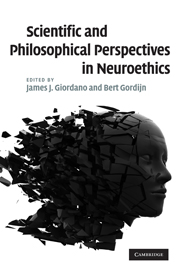Book contents
- Frontmatter
- Contents
- List of contributors
- Preface
- Acknowledgments
- Introduction
- 1 Developments in neuroscience
- 2 The origins of the modern concept of “neuroscience”
- 3 On the cusp
- 4 The mind-body issue
- 5 Personal identity and the nature of the self
- 6 Religious issues and the question of moral autonomy
- 7 Toward a cognitive neurobiology of the moral virtues
- 8 From a neurophilosophy of pain to a neuroethics of pain care
- 9 Transplantation and xenotransplantation
- 10 Neurogenetics and ethics
- 11 Neuroimaging
- 12 Can we read minds?
- 13 Possibilities, limits, and implications of brain-computer interfacing technologies
- 14 Neural engineering
- 15 Neurotechnology as a public good
- 16 Globalization: pluralist concerns and contexts
- 17 The human condition and strivings to flourish
- 18 The limits of neuro-talk
- Afterword
- Index
5 - Personal identity and the nature of the self
Published online by Cambridge University Press: 07 May 2010
- Frontmatter
- Contents
- List of contributors
- Preface
- Acknowledgments
- Introduction
- 1 Developments in neuroscience
- 2 The origins of the modern concept of “neuroscience”
- 3 On the cusp
- 4 The mind-body issue
- 5 Personal identity and the nature of the self
- 6 Religious issues and the question of moral autonomy
- 7 Toward a cognitive neurobiology of the moral virtues
- 8 From a neurophilosophy of pain to a neuroethics of pain care
- 9 Transplantation and xenotransplantation
- 10 Neurogenetics and ethics
- 11 Neuroimaging
- 12 Can we read minds?
- 13 Possibilities, limits, and implications of brain-computer interfacing technologies
- 14 Neural engineering
- 15 Neurotechnology as a public good
- 16 Globalization: pluralist concerns and contexts
- 17 The human condition and strivings to flourish
- 18 The limits of neuro-talk
- Afterword
- Index
Summary
We all of us, grave or light, get our thoughts entangled in metaphors, and act fatally on the strength of them.
G. Eliot, MiddlemarchWhat is a person? What is the self? These are tough questions, indeed. They are so tricky that it is difficult even to imagine what answering them would look like. A person, a self, is not something in the objective world that we could point our finger at. Look at that: a self! That sounds queer. We need a theory of the self – and a very special theory, too – in order to speak about something that lies exactly on the border between inner and outer, value and fact, subjective and objective. As selves, we make acquaintance with the interface between different logical spaces and we come out of this experience baffled. As Augustine used to say about time, we do not have trouble with such familiar notions until someone prompts us to make explicit sense of them. Then, we get stuck in a tangle of doubts. I know that I am a self. (I am myself! My very language is compelling me to admit it.) But I do not know much more about it. Well, of course, I understand that it is me the person who is writing the first tortuous lines of a chapter that will force me to come out into the open and take sides on subject matters that put our intellectual faculties to a hard test.
- Type
- Chapter
- Information
- Scientific and Philosophical Perspectives in Neuroethics , pp. 117 - 133Publisher: Cambridge University PressPrint publication year: 2010
- 2
- Cited by

